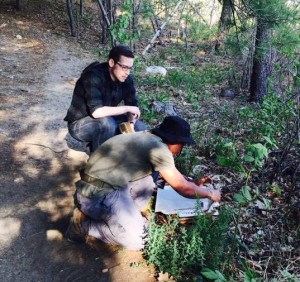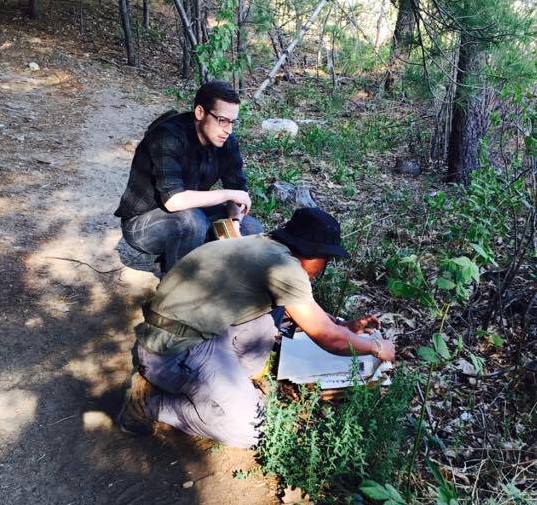by Sage Wesenberg
Northeastern chemistry PhD candidate and ethnobotanist John de la Parra’s love of plants has brought him very far in life so far. Recent recipient of the President’s Award from the Society of Economic Botany and winner in the Excellence in Innovation Award for his poster on “Controlled Biosynthesis and Diversification of Plant-Derived Pharmaceuticals” at Northeastern’s RISE, de la Parra is quite busy in his research, attending events and competitions to share his work with others.
de la Parra was an undergraduate student at The Cooper Union in New York City, studying chemical engineering. As a student living in the big city of New York after growing up on a farm in Alabama, de la Parra quickly realized how much he missed nature. He missed it so much that he would go for barefoot walks in Central Park so he could feel the grass between his toes. But Alabama was where his love for plants began. “We relied on plants, we grew everything we ate, and my grandmother used to use plants to heal.” he said. After completing his studies at The Cooper Union, de la Parra got certified in horticulture and began taking graduate courses in botany, anthropology, and pharmacology; exploring his passion for investigating how people and plants interact. While taking classes and doing plant research, de la Parra taught chemistry at a local college and began to develop a course combining his two interests: ‘Medicinal Plants: From the Sacred to the Scientific’. He loved teaching in lecture and in lab, especially when tying in plants and getting students excited about them. “This is how I planted the seed, so to speak, and a PhD could possibly allow me to teach what I loved at a university as well as advance in research,” de la Parra said with a laugh. So he soon left the Big Apple for the University of South Florida where he took more graduate classes at the Morsani College of Medicine and continued medicinal plant research and consulting for both academia and industry. While he was there, he decided he wanted to earn his PhD and Northeastern Associate Professor Carolyn Lee-Parsons offered him a unique opportunity to work with plant tissue cultures. Since then, his work has brought him to work under Northeastern analytical chemists Dr. Jared Auclair and Professor Bill Hancock, as well as a chance to gain innovative natural products insight through Professors Philip LeQuesne and Roman Manetsch. Additionally, through a collaboration he developed with Harvard and Brown Universities, de la Parra has grown his plant collection and worked with Northeastern’s Biopharmaceutical Analysis Training Lab to investigate the molecules that plants produce naturally for medicines, while also bringing in traditionally used, yet unanalyzed plants to test against relevant bioassays
Ethnobotany is a unique discipline in the northeast. One of de la Parra’s goals is to find plants for new medicines from indigenous cultural practices and then bring in the full power of modern biotechnology to create a a controllable platform to create the medicines desperately needed for disease. This is a field that de la Parra has coined “ethnophytotechnology.” In essence, he sees it as a field where scientists begin “informing cutting edge plant biotechnology applications with ethnobotanical information.” At Northeastern, he started off focusing on just tissue cultures, but has now moved in the direction of analytical chemistry like mass spectrometry and chromatography to analyze plant materials.

John de la Parra conducting fieldwork with Brown University student Brandon Dale. (courtesy photo)
His RISE poster focused on his work with tissue cultures in Professor Lee-Parsons’ laboratory as well as his analytical work with Auclair and LeQuesne. In general terms, de la Parra describes the work in the following way. He took the living cells of a medicinal plant and grew them as a tissue culture in a flask, which is an ideal platform for genetically engineering. However, thinking as a botanist first and then as a chemist, de la Parra subjected the tissue cultures to various defense hormones under different conditions. Plants use hormones to regulate metabolism, and adding hormones at different dosages and timings can cause plants to upregulate the production of small molecules that had never been seen to accumulate before — and that could have pharmaceutical benefits. With cultures, the compound can then be made in scalable conditions controlled in a lab, rather than relying on the fluctuations that can be found naturally in a leaf or other plant organ.
While all of this is incredibly impressive, de la Parra is very humble about his accomplishments. He was very passionate in explaining his current work. Last month, de la Parra took a camera crew to the Everglades, to accompany his search for a plant used by the Seminole Indian Tribe to treat skin infections. He collected the plant, interviewed the local botanist that originally identified the plant, and spoke with the indigenous groups that have been using the plant for many years. Now that he has the plant back in his lab, he can test its compounds to learn more about it. Through the anthropological story of the plant and his background in chemistry and lab work, de la Parra is able to create a very well-rounded picture of every plant he studies, to help have better impacts on society. de la Parra is also very interested in finding medicinal plants for neglected tropical diseases like Sleeping Sickness, Chagas disease, and malaria.
When he’s not identifying indigenous plants, de la Parra is also very interested in green chemistry. In late June, he attended the ACS Green Chemistry Institute in Golden, Colorado. This was a weeklong conference that hundreds of PhD students and post-doctoral scholars apply for and attend to listen to professors and speakers from around the world discuss their ideas on green chemistry and sustainable energy. de la Parra describes the experience as some very intense, information-filled days, but full of fascinating discussions on topics like fracking, greener syntheses of chemicals, and more. He was selected to attend the institute because of his ongoing work here at Northeastern with Professor Vasiliki Lykourinou, with whom he is working to develop a lab curriculum that uses cleaner, greener chemistry techniques. So far, they have a whole year of new laboratories planned for the chemistry majors, hoping to soon expand across many majors. In August, de la Parra will attend the American Chemical Society conference to present his innovations in a green procedure to extraction of plant material.
de la Parra’s life is full of plants, teaching, research, and using his abilities to help others. He is using his success to further important research in medicinal studies and discovering ways to be greener in lab and in life. He seems infinitely excited about everything he does. “I always feel very lucky that I can do something I’m passionate about,” he said.

Chemistry PhD student John de la Parra (courtesy photo)

